
“Do corn snakes need UVB?” is a question that has piqued the curiosity of many reptile enthusiasts and corn snake owners.
As these captivating creatures slither their way into our homes and hearts, understanding their unique needs becomes paramount.
This article delves deep into the world of corn snakes and their relationship with UVB lighting.
We’ve sifted through the debates, analyzed recent studies, and compiled expert recommendations to bring you a comprehensive guide.
By the end of this read, you’ll not only grasp the significance of UVB for corn snakes but also learn how to optimize their environment for their utmost well-being.
Dive in to ensure your slithery friend thrives in the best conditions possible!
Table of Contents
- 1 Do Corn Snakes Need UVB? (Short Explanation)
- 2 The Importance of Understanding Their Lighting Needs
- 3 The Natural Lighting Cycle for Corn Snakes
- 4 Do Corn Snakes Need UVB?
- 5 How to Install UVB for Corn Snakes
- 6 Night Lighting for Corn Snakes
- 7 Heating Requirements for Corn Snakes
- 8 Humidity Needs for Corn Snakes
- 9 Conclusion
- 10 FAQ
Do Corn Snakes Need UVB? (Short Explanation)
Yes, corn snakes can benefit from UVB lighting. While they can survive without it, recent studies indicate that UVB exposure can be beneficial for their overall health. In the wild, corn snakes are occasionally exposed to UVB rays from the sun. UVB aids in vitamin D3 synthesis, which in turn helps with calcium absorption, crucial for bone health. Moreover, UVB lighting can enhance their captive environment, promoting natural behaviors and better well-being. Therefore, while it’s not strictly mandatory, providing UVB lighting for corn snakes in captivity is a step towards ensuring they don’t just survive, but thrive.
The Importance of Understanding Their Lighting Needs
When it comes to the well-being of our slithery friends, understanding their lighting needs is paramount.

Just as humans need sunlight for Vitamin D synthesis and maintaining our circadian rhythm, reptiles, like the corn snake, have specific lighting requirements that play a crucial role in their health and behavior.
The question “do corn snakes need UVB?” isn’t just a matter of curiosity. It’s about ensuring these creatures thrive in captivity, not just survive.
Imagine being stuck in a room with the same light setting 24/7. Sounds dreary, right? For corn snakes, the implications go beyond mere discomfort.
Proper lighting can affect their feeding patterns, shedding, and overall mood. So, let’s dive deeper into the world of corn snakes and their relationship with light.
The Natural Lighting Cycle for Corn Snakes
Corn Snakes’ Activity Around Nighttime
Corn snakes are fascinating creatures. While they’re not strictly nocturnal, they tend to be most active during the dusk and dawn hours.
This behavior, known as crepuscular activity, means they’re on the move when the sun’s rays aren’t at their peak. It’s a clever adaptation, allowing them to hunt in cooler temperatures while avoiding many daytime predators.
But just because they’re active during these hours doesn’t mean they don’t benefit from the sun’s rays.
The Significance of a Distinct Day/Night Cycle in Captivity
In the wild, the sun dictates a corn snake’s day. The rising sun signals a new day, and its setting indicates it’s time to retreat. In captivity, replicating this natural day/night cycle is essential for their mental well-being.
Without it, they can become stressed, leading to health issues and erratic behavior. Think of it as our need for a good night’s sleep. Without it, we’re groggy, irritable, and not at our best.
For corn snakes, a proper lighting cycle helps regulate their internal clock, ensuring they’re active, alert, and healthy.
Benefits of Terrarium-Specific Lighting for Corn Snakes
Now, let’s address the elephant in the room: UVB lighting. While it’s true that corn snakes can survive without UVB exposure, recent studies suggest they thrive with it.

UVB lighting in terrariums can mimic the beneficial UVB rays they’d receive in the wild, promoting better calcium absorption and overall health.
Moreover, terrarium-specific lighting can enhance their environment, making colors more vibrant and encouraging natural behaviors.
For instance, with the right lighting setup, you might notice your corn snake exploring more, showcasing its natural hunting techniques, or basking under the light, absorbing those beneficial rays.
Incorporating the right lighting isn’t just about aesthetics or ticking off a checklist. It’s about creating an environment where our corn snakes can exhibit their natural behaviors, stay healthy, and live a fulfilling life.
So, the next time you ponder on the lighting needs of your corn snake, remember: it’s not just light; it’s life.
Do Corn Snakes Need UVB?
Exposure of Wild Corn Snakes to UVB
In their natural habitats, corn snakes are exposed to a myriad of light conditions, including direct and indirect UVB rays from the sun.
These crepuscular creatures, active primarily during dawn and dusk, often bask in the sun during the early morning or late afternoon.
This sunbathing not only helps regulate their body temperature but also exposes them to beneficial UVB rays, even if it’s for a limited duration.
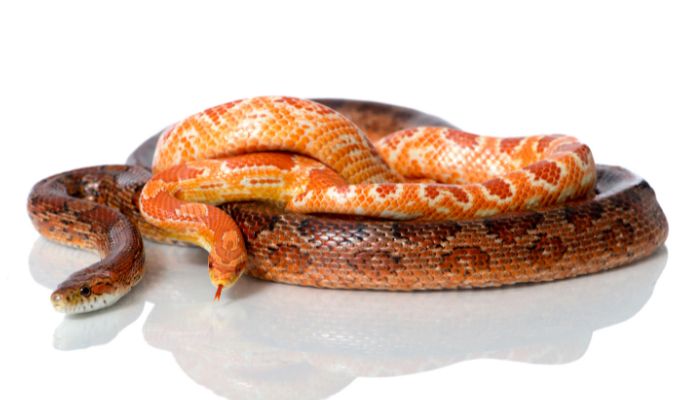
Conventional Beliefs vs. Recent Studies on UVB for Snakes
Historically, the reptile-keeping community believed that snakes, including corn snakes, didn’t require UVB lighting in captivity. This belief stemmed from the observation that many snakes seemed to fare well without it.
However, as reptile care evolved and research deepened, a shift in this perspective emerged. Recent studies have shown that while snakes can survive without UVB, they can thrive with it.
These studies suggest that UVB exposure can lead to improved health, better calcium absorption, and even enhanced colors in some snake species.
The Role of UVB in Ensuring Mental and Physical Health
UVB plays a pivotal role in the synthesis of vitamin D3 in reptiles. This vitamin aids in calcium absorption, crucial for bone health and preventing conditions like Metabolic Bone Disease.
Beyond the physical, there’s a mental aspect to consider. Proper lighting, including UVB, can simulate a more natural environment for captive corn snakes.
This can lead to reduced stress, more active behavior, and an overall happier snake.
Recommendations for Using UVB Lighting in Captivity
For those considering introducing UVB lighting to their corn snake’s enclosure, it’s essential to do so responsibly. A 5-7% UVB bulb is typically recommended for corn snakes.
Ensure the snake can bask within 10-12 inches of the light, but also provide shaded areas for retreat.
Remember, it’s about replicating their natural environment, where they can choose when and how much UVB exposure they receive.
How to Install UVB for Corn Snakes
Importance of UVB Intensity and Its Relation to Distance
UVB intensity diminishes with distance. This means that the closer your corn snake is to the UVB source, the more intense the exposure. Conversely, the further away they are, the less UVB they receive.
It’s crucial to strike a balance, ensuring they get adequate exposure without the risk of overexposure.
Recommendations for UVB Bulb Placement and Types
For corn snakes, a linear fluorescent UVB bulb or a compact UVB bulb can work well. Place the bulb over the basking area, ensuring there’s a gradient so the snake can move closer or further away as needed.
Avoid placing the bulb at the extreme ends of the enclosure to prevent the snake from avoiding UVB entirely.
The Significance of Changing UVB Bulbs Regularly
UVB bulbs lose their effectiveness over time. Even if they’re still emitting visible light, the UVB output can diminish.
It’s recommended to change UVB bulbs every 6-12 months to ensure consistent and effective UVB exposure.
Tips for Ensuring Effective UVB Exposure
- Avoid Glass and Plastic: UVB rays don’t penetrate through regular glass or plastic. Ensure the bulb is placed in a position where it’s not obstructed by these materials.
- Use Reflectors: Reflectors can help direct the UVB rays downwards, maximizing the exposure your corn snake receives.
- Monitor Behavior: Keep an eye on your snake’s behavior. If they’re constantly avoiding the basking area or seem stressed, you might need to adjust the lighting setup.
While UVB isn’t a strict necessity for corn snakes, it can significantly enhance their quality of life in captivity.
By understanding their needs and setting up their environment thoughtfully, you can ensure your slithery friend leads a healthy, happy life.
Night Lighting for Corn Snakes
The Debate on Nighttime Lighting for Corn Snakes
Nighttime lighting for corn snakes is a topic of much debate among reptile enthusiasts. Some argue that providing a light source during the night can help replicate moonlight, offering a more natural environment.
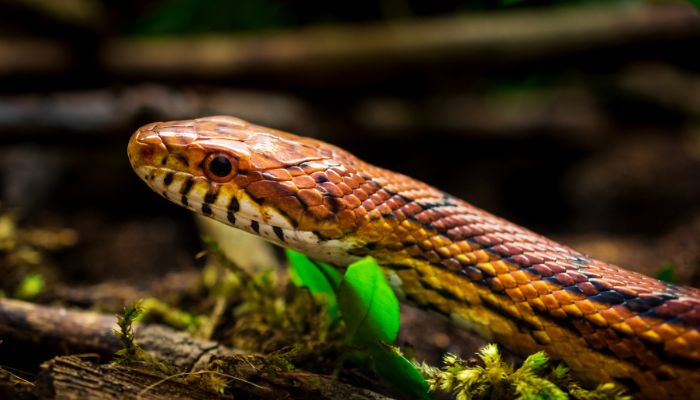
Others believe that corn snakes, being crepuscular, benefit from a period of complete darkness, allowing them to rest and maintain their natural rhythms.
Potential Risks and Recommendations
Continuous exposure to light, even if dim, can disrupt a corn snake’s circadian rhythm. This disruption can lead to stress, irregular feeding patterns, and even health issues in the long run.
It’s essential to remember that in the wild, even on a full moon night, the light isn’t as bright as artificial lighting. If you’re considering nighttime lighting, opt for a very dim light and ensure it doesn’t produce any heat.
Alternatively, consider providing a natural light cycle by allowing ambient light from the room or outside to play its part, without any additional artificial sources.
Heating Requirements for Corn Snakes
Understanding Ectothermic Nature of Corn Snakes
Corn snakes, like all reptiles, are ectothermic. This means they rely on external sources to regulate their body temperature.
They don’t produce internal heat like mammals. Instead, they move to warmer or cooler areas as needed to maintain their optimal body temperature. This behavior is why you’ll often see reptiles basking in the sun or retreating to shaded areas.
Importance of Temperature Gradients in the Enclosure
A temperature gradient is crucial in a corn snake’s enclosure. It allows the snake to self-regulate its temperature by moving between the warmer basking area and the cooler end.
Without this gradient, the snake can’t adjust its body temperature effectively, leading to potential health issues.
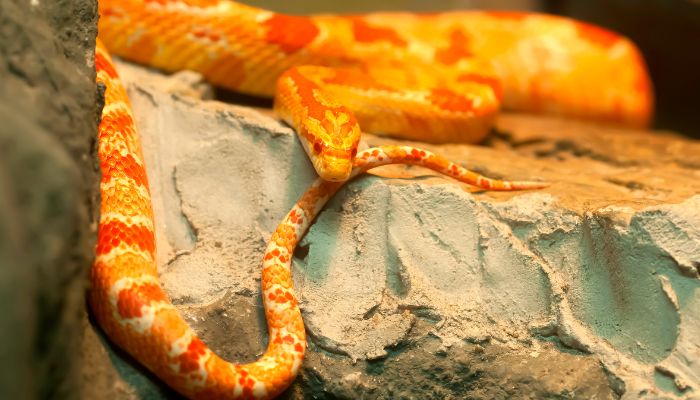
Recommendations for Basking Temperatures and Nighttime Temperatures
For corn snakes, the ideal basking temperature ranges between 85°F to 88°F. The cooler end of the enclosure should be around 70°F to 75°F. At night, temperatures can drop slightly but should remain above 65°F to ensure the snake doesn’t get too cold.
Effective Methods for Heating a Corn Snake’s Enclosure
- Under Tank Heaters (UTH): These are placed beneath the enclosure and provide a consistent heat source. They’re great for creating a warm basking spot.
- Basking Bulbs: These are light bulbs that emit heat. They should be placed above the enclosure, ensuring the snake can’t come in direct contact with them.
- Ceramic Heat Emitters (CHE): These are like basking bulbs but don’t emit light, making them suitable for maintaining nighttime temperatures.
- Heat Tape: This is a versatile heating option that can be customized to fit various enclosure sizes.
Always use a thermostat with heating devices to prevent overheating. Regularly monitor temperatures using a reliable thermometer to ensure your corn snake’s environment remains optimal.
Understanding and catering to the heating needs of corn snakes is paramount. By providing the right temperatures and gradients, you’re ensuring a comfortable and healthy environment for your reptilian companion.
Humidity Needs for Corn Snakes
The Significance of Humidity for Corn Snakes
Humidity plays a pivotal role in the well-being of corn snakes. In their natural habitat, these snakes experience varying levels of humidity, which aids in processes like shedding and hydration.
Proper humidity ensures that when your corn snake sheds its skin, the process is smooth, and the old skin comes off in one complete piece.
Inadequate humidity can lead to incomplete shedding, where bits of old skin cling to the snake, potentially leading to health issues.
Tips for Maintaining Optimal Humidity Levels
- Substrate Choice: Using a moisture-retaining substrate like cypress mulch or coconut coir can help maintain humidity. Avoid substrates like sand or aspen, which can dry out the environment.
- Misting: Regularly misting the enclosure with water can boost humidity levels. However, ensure the enclosure doesn’t become too wet, as this can lead to mold growth.
- Water Bowl: Place a sizable water bowl in the enclosure. Not only does it provide hydration for your snake, but the water’s evaporation also helps increase humidity.
- Enclosure Cover: Using a partial cover on the top of mesh-topped enclosures can help retain moisture and maintain humidity.
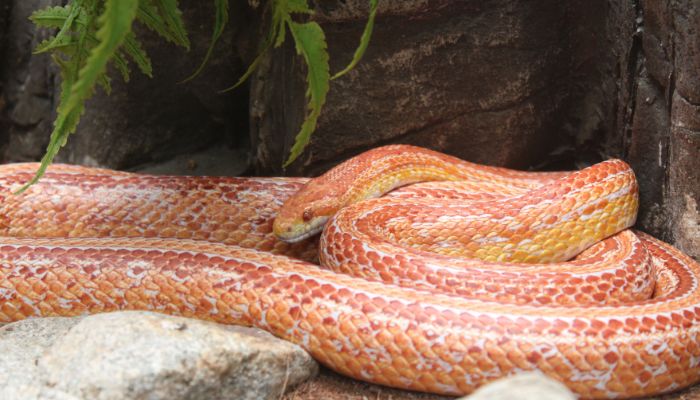
Importance of Monitoring and Adjusting Humidity
Regularly monitoring humidity levels is crucial. Fluctuations can occur due to external factors like room temperature or seasonal changes.
Using a reliable hygrometer can help you keep track. Aim for a humidity level between 40% to 60% for corn snakes.
If levels drop too low, increase misting or adjust the substrate. If too high, consider increasing ventilation or adjusting the water bowl’s size.
Conclusion
Corn snakes, with their vibrant colors and docile nature, are a favorite among reptile enthusiasts. But as with all pets, they come with specific needs.
From the debated UVB requirements to the essential temperature and humidity levels, understanding and catering to these needs is paramount for their well-being.
The importance of UVB and other environmental factors cannot be stressed enough.
While they might survive without them, to see your corn snake truly thrive, it’s essential to replicate their natural habitat as closely as possible in captivity.
Owning a corn snake, or any pet for that matter, is a responsibility.
It’s not just about feeding them and admiring their beauty. It’s about understanding their needs, continually educating oneself, and making informed decisions for their care.
In the end, responsible and informed pet ownership doesn’t just benefit the pet. It enriches our lives, teaching us empathy, patience, and the joy of seeing a creature flourish under our care.
So, as you ponder on the lighting, heating, and humidity needs of your corn snake, remember: it’s a journey of learning, love, and mutual respect.
FAQ
How much UVB does a corn snake need?
Corn snakes, like many reptiles, benefit from UVB exposure, but the intensity and duration should be moderated. In captivity, a 5-7% UVB bulb is typically recommended. It’s essential to ensure that the snake can bask within 10-12 inches of the light for a few hours each day, replicating the sporadic UVB exposure they’d receive in the wild. However, always provide shaded areas for retreat, allowing the snake to choose when and how much UVB exposure they receive.
Is 5.0 UVB good for corn snakes?
Yes, a 5.0 UVB bulb is suitable for corn snakes. This bulb emits a moderate level of UVB, replicating the conditions corn snakes would experience in their natural habitat. When setting up the lighting, ensure the snake has the option to bask close to the bulb or retreat to a shaded area, giving them control over their UVB exposure.
What is the best UVB light for corn snakes?
The best UVB light for corn snakes is typically a linear fluorescent UVB bulb or a compact UVB bulb with a 5.0 or 7.0 rating. Brands like Zoo Med and Exo Terra are reputable and offer reliable UVB bulbs suitable for corn snakes. Always ensure the bulb is placed in a position where the snake can get close enough for effective exposure but also has areas to retreat from the light.
Do snakes need UVB?
While snakes can survive without UVB, recent studies suggest they benefit from it. UVB aids in vitamin D3 synthesis, which helps with calcium absorption, crucial for bone health. While not all snakes in captivity are provided with UVB, incorporating it can enhance their overall health and well-being. It’s always a good idea to research the specific needs of the snake species you’re caring for.
Is UVA or UVB better for snakes?
Both UVA and UVB have their significance in reptile care. UVA stimulates natural behaviors like feeding, mating, and basking. It plays a role in the psychological well-being of reptiles. UVB, on the other hand, aids in vitamin D3 synthesis and calcium absorption. For snakes, and especially for corn snakes, UVB is more crucial for its role in health. However, many reptile bulbs offer a combination of UVA and UVB, ensuring your snake benefits from both types of ultraviolet light.

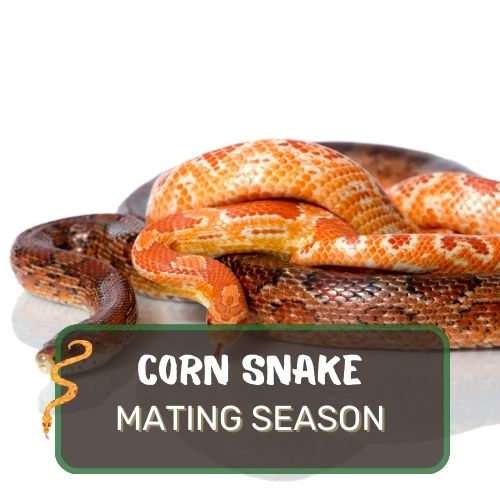
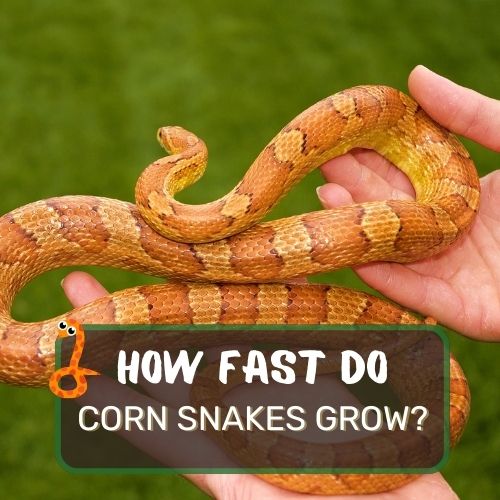

0 Comments